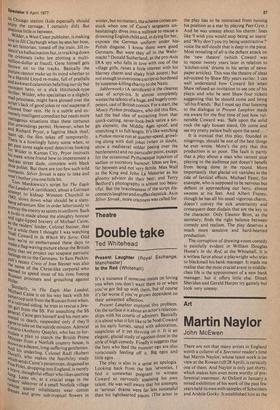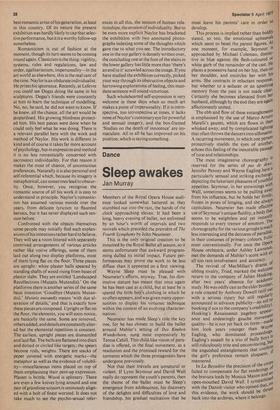Theatre
Double take
Ted Whitehead
Present Laughter (Royal Exchange, Manchester) In the Red (Whitehall) It's a nuisance if someone insists on loving you when you don't want them to or when you've got fed up with them, it's far worse if you've grown dependent on but of course their unwanted affection. Present Laughter explores this problem. On the surface it is about an actor's relationships with his coterie of admirers. Basically it is about what it felt like to be Noel Coward in his early forties, sated with admiration, suspicious of it yet thriving on it. It is an elegant, glacial study of egotism done in the style of high comedy. Finally it suggests that the fans who feed the monster ego are also voraciously feeding off it. Big egos and little egos .. .
The play is also in a sense an apologia. Looking back from the late 'seventies, I find it somewhat poignant to witness Coward so nervously assessing his own talent. He was well aware that his attempts at 'serious' drama were far less successful than his lighthearted pieces. (The actor in
the play has to be restrained from ruining his position as a star by playing Peer Gynt.) And he was uneasy about his charm: lines like 'I wish you would stop being so suave' and 'Why don't you try being unattractive?' voice the self-doubt that is deep in the piece. Most revealing of all is the defiant attack on the 'new theatre' (which Coward was to repeat twenty years later in relation to 'kitchen-sink' drama in his series of newspaper articles). This was the theatre of ideas advocated by Shaw fifty years earlier. I can well understand how Coward felt when Shaw refused an invitation to see one of his plays; and why he sent Shaw four tickets suggesting that he should come and bring 'all his friends.' But I must say that listening to the dialogue in Present Laughter made me aware for the first time of just how vulnerable Coward was. 'Safe upon the solid rock the ugly houses stand, Oh come and see my pretty palace built upon the sand ...'
It is ironical that this play, founded in misgivings, should be one of the best things he ever wrote. More's the pity that this production is so poor. The fault is partly that a play about a man who cannot stop playing to the audience just doesn't benefit from being done in the round. More importantly that glacial wit vanishes in the tide of farcical effects. Michael Feast, for example, who is supposed to be nervous but defiant in approaching our hero, almost swoons at his feet. And Albert Finney, though he has all his usual vigorous charm, doesn't convey the sick uncertainty and consequent deep disdain that are the key to the character. Only Eleanor Bron, as the secretary, finds the right balance between comedy and realism. The play deserves a much more sensitive and hard-hearted production.
The corruption of drawing-room comedy is painfully evident in William Douglas Home's In the Red, at the Whitehall. It is a witless farce about a playwright who tries to blackmail his bank manager. It made me realise that the most crucial event in middleclass life is the appointment of a new bank manager, but it offers little else. Dinah Sheridan and Gerald Harper try gamely but look very uneasy.
best romantic artist of his generation, at least in this country. Of its nature the present exhibition was hardly likely to cap that selective performance, but it is a worthy follow-up nonetheless.
Romanticism is out of fashion at the moment, though its turn seems to be coming round again. Classicism is the thing: rigidity, systems, rules and regulations, law and order, egalitarianism, impersonality—in the art world as elsewhere, this is the real cant of the time. Naylor is an obdurate i ndividualist. He prizes his ignorance. Recently, at Lefevre you could see Degas doing the same in his sculptures. Degas's friends were constantly at him to learn the technique of modelling. No, no, he said, he did not want to know. If he knew, all the chance, all the art would be jeopardised. His growing blindness protected him. His best pieces were done when he could only feel what he was doing. There is a relevant parallel here with the work and method of Naylor. His work is different in kind and of course it takes far more account of psychology, but in expression and method it is no less romantically concerned with sacrosanct individuality. For that reason it makes the most of chance, of unconscious preferences. Naturally it is also personal and self-referential which, because its imagery is metaphorical, can sometimes lead to obscurity. Once, however, you recognise the romantic source of all his work it is easy to understand in principle. Naylor's romanticism has assumed various moods over the years, from delicate lyricism to flaunted heroics, but it has never displayed such tension before.
Confronted with the objects themselves some people may initially find such explanations of his intentions rather hard to believe. They will see a room littered with separately contrived arrangements of various articles rather like votive offerings, some of them laid out along two display platforms, most of them lying flat on the floor. Three pieces are upright : white plaster balls speared by standing shafts of wood rising from bases of plaster slabs. They are entitled 'Landscaped Recollections (Mutatis Mutandis).' On the platforms there is another series of the same basic intention 'Goodbye (Mutatis Mutandis).' Mutatis nultandis means 'with due alteration of details,' and that is exactly how these pieces are composed. Upright or flat on the floor, the elements, you will soon notice, are basically the same. Some are removed, othersadded,and detailsareconstantly altered but the elemental repetition is constant. The earliest, upright pieces are dismantled and laid flat. The balls are flattened into discs and dotted or circled like targets; the spears become rods, weights. There are stacks of peper covered with energetic marks—the metaphor as well as the evidence of volubility—miscellaneous items placed on top of them emphasising their pent-up expression. Plaster is brittle. Wood is splintery. There are even a few knives lying around and one pair of grandiose scissors is ominously aligned with a .bolt of finest worsted. It does not take much to see the psycho-sexual refer
ences in all this, the tension of human relationships, the erosion of individuality. But to be even more explicit Naylor has bracketed the exhibition with two annotated photographs indexing some of the thoughts which gave rise to what you see. The introductory one in the top gallery is densely written over, the concluding one at the foot of the stairs in the lower gallery has little more than `there's an end to it' scrawled across the image. If you have studied the exhibition correctly, picked your way through its obstructive objects and harrowing explorations of feeling, this mundane sentence will sound victorious.
Such wholehearted self-expression is very welcome in these days when so much art makes a point of impersonality. If it is introspective, too introspective at times, it lacks none of Naylor's customary eye for powerful and sensual imagery, and the box-framed 'Studies on the death of innocence' are immaculate. All in all he has improved on his position, which is saying something.

































 Previous page
Previous page